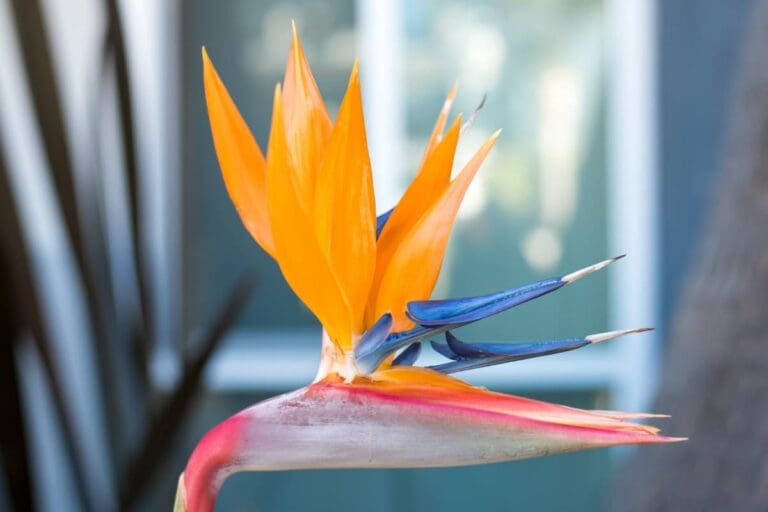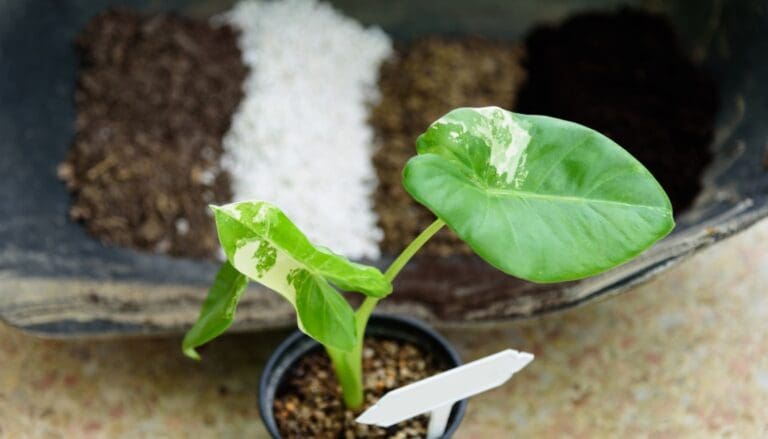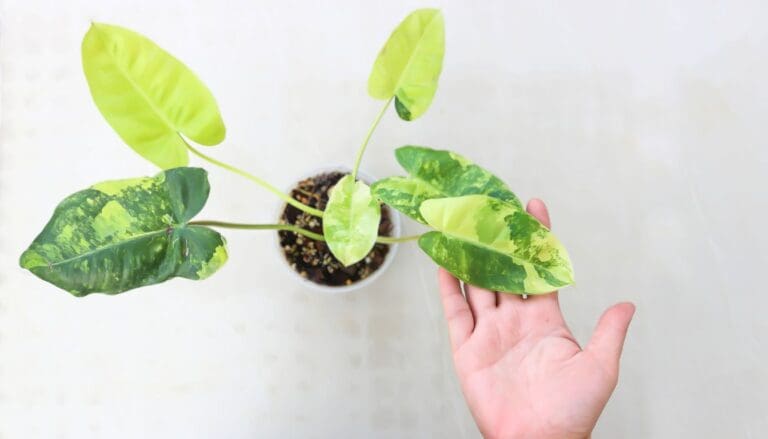Do Peperomia Plants Need Fertilizer? (+Best Fertilizer Pick)
Peperomia will be an ideal choice if you are a forgetful gardener. But if you want to promote healthy growth in your peperomia, you must fertilize it properly. But what kind of fertilizer do peperomia need and how much?
As a general rule, peperomia thrives when dosed with a fertilizer with an NPK ratio of 3:1:2. However, you can use any balanced fertilizer as well. Make sure to fertilize once a month in the growing season and dilute the fertilizer to half the recommended dosage to prevent overfertilization.
If you want your peperomia to thrive for many years, then the right fertilization is essential. It’s always a good practice to fertilize the plant once a month.
If you want to understand the details of the fertilization of peperomia, keep skimming through this article. If you gather proper knowledge, you will be able to avoid mistakes.

Please note: Simplify Plants is reader-supported. Some links in the post are affiliate links and I get a commission from purchases made through links in the post.
Why is fertilization important for peperomia?
Nature always sources surplus fertilization for peperomia grown naturally. But when they are grown in the pots with artificial care and diligence, you need to add adequate macro and micronutrients through fertilization.
Water itself is an excellent nutrient for any indoor plant but not sufficient to feed all its necessities of minerals. The right amount of light and a favorable temperature are essential factors required for the proper growth of plants.
Soil with the right amount of minerals is an essential parameter for a plant’s survival and growth. When adding nutrients to the soil of the pot, fertilizer plays a vital role.
But it’s vital to pick up the right fertilizer for the indoor plant. Otherwise, the peperomia may face the following consequences:
- Immature growth
- Fresh leaves turning yellow
- Feeble roots
If you notice any early signs of overfertilization or under fertilization on your peperomia plant, you must change the fertilizer and apply a suitable one.
What nutrients does fertilizer contain?

Indoor plants’ fertilizers contain many ingredients. These ingredients are mainly classified as macronutrients and macronutrients. The three essential macronutrients are nitrogen, phosphorous, and potassium.
We can include calcium, magnesium, and sulfur in the list of micronutrients. Not much amount of these elements are needed. But they contribute significantly to the plant’s health.
Nitrogen is essential for photosynthesis. Potassium is the primary macronutrient to stimulate stem growth. Phosphorus encourages root growth.
Copper, Zinc, Iron bears importance too when it comes to Peporium’s sound blooming.
Peperomia requires a fertilizer with an NPK ratio of 3:1:2. That means that the fertilizer contains 30% nitrogen, 10% phosphorus, and 20% potassium.
NPK overall boosts the plants’ growth and develops their immunity.
Once you develop a clear understanding of the number of nutrients, you will be an expert while selecting the suitable fertilizers for your plant.
After all, who knows your plants better than you.
The best fertilizer for peperomia
A well-balanced fertilizer for peperomia plants should maintain an NPK ratio of 3:1:2. Nitrogen, Potassium, and Phosphorous in the perfect composition will satisfy all growth needs of peperomia.
However, you can also use a fertilizer with a 10:10:10 or 20:20:20 ratio in case the exact one is not available.
Some of my top picks of fertilizer for peperomia plants are:
- Fiddle Leaf Fig Tree Plant Food (3:1:2 Ratio)
- Jacks Classic 20-20-20 All Purpose Fertilizer
- Espoma Organic Indoor Plant Food
- Charlie’s Compost
While choosing a fertilizer, make sure you check its composition and match your plant’s nutrients criteria, Let’s have a close look at the types of fertilizers available out in the market and pick up the right one for yours.
Types of fertilizers

You may primarily find three types of fertilizers in the market: liquid, granular, and slow release. Peperomia is not a heavy feeder. Therefore, fertilizer diluted to half strength is more than enough for it.
You may go for liquid fertilizers as those are easy to use. But you must figure out how much strength and amount is required for your loving plants. Feeding a liquid fertilizer to a plant is easier as compared to the other fertilizers.
Liquid fertilizer
Liquid fertilizer may be either a condensed liquid or a powder that needs to be mixed with water. After mixing, you need to pour the preparation from your watering jug onto your plant.
The dilution of liquid fertilizer isn’t a big deal. It gives you enough control over selecting the correct quantity to apply to your peperomia.
Granular fertilizer
Granular fertilizers are pellets. You can mix it with potting soil to feed a plant. This kind of fertilizer delivers all the nutrients at one time.
As a result, peperomia may lose balance in its nutrients and will end up being overfed. The leaves might even burn. These are some reasons why granular fertilizers are not recommended.
Slow-release fertilizer
Slow-release fertilizers are made of pellets or stakes. They are covered in a time-release shell that permits the fertilizer to slowly release nutrients into the soil every time you water it. The only disadvantage is – these formulas cannot be changed or diluted easily.
Considering all three types of fertilizers, I would suggest you go liquid fertilizers. Even stats say that liquid fertilizers are the most loved ones in the market.
Fertilizers can also be classified into two other sections –
- Commercial
- Homemade
Commercial fertilizer
Commercial fertilizers are those we can buy from markets or online stores. A wide range of brands is available out there. Each of them is equally good and trusted by the experts. You can use any of them based on your peperomia’s nutrients demand.
The commercial fertilizers mainly emphasize the NPK ratio. A well-balanced fertilizer should have an equal amount of essential nutrients: nitrogen, phosphorus, and potassium.
A fertilizer having an NPK ratio of 20:20:20 is ideal for all the houseplants like peperomia that need a stable and balanced fertilizer.
If you want to boost your peperomia’s growth, you should go for fertilizer with a higher nitrogen percentage. If your plant lacks stem growth, select a fertilizer with a higher percentage of potassium. And in case of slow root growth, choose phosphorus dominating fertilizers.
Homemade fertilizer
You can also use homemade fertilizers in case you don’t want to use commercial ones. However, it would help to be very careful while using these as you don’t know the nutrients’ composition.
You can also make organic fertilizers at home and get all the essential macro and micronutrients.
Check out some of the most useful homemade fertilizers here –
Banana peels
Banana peels contain the organic form of potassium with a small amount of nitrogen and phosphorus and calcium, sodium, and manganese.
You need to cut banana peels into small pieces and put them in a jar of water. Seal the jar and set this aside for a week. On the last day, when the color becomes brown, remove the peels from the water. Mix 50% of this with normal water and give it to the peperomia.
If you observe any discoloration of the plant’s leaves, you may use this fertilizer to supply a good amount of potassium. It will solve your problem within two weeks.
Instead of banana, you can use potato or mango peels too.
Rice water fertilizers
It is a mild fertilizer that contributes a small NPK ratio to the soil in the pot. To add more, starch present in it increases beneficial soil bacteria growth.
There are many other benefits of using rice water as fertilizer. You can take some rice and pour it into a bowl with water.
Rinse the rice for few minutes. Then let it soak for 30-40 minutes. After that, stir the water and strain it in a bowl and give it to your peperomia.
You can also use the water that you get after boiling rice. You can add some water to that water as it is usually a thick residue. Ensure that it is room temperature before you give it to your peperomia.
Egg Shells
Eggshell is a source of multi-nutrients to the soil – calcium, organic matter, magnesium, sodium, phosphorus, potassium, etc.
If you notice stunted growth or the leaves curling inwards in your peperomia plant, it shows your plant has a calcium deficiency.
To remove it, blend the shells into a powder form and mix it with the soil.
A word of caution here! Eggshells have a small amount of sodium too, and sodium is considered poisonous to plants. Our suggestion is to check the number of eggshells you are applying to your plants.
Aquarium water

Aquarium water will contain nutrients from the fish poop. It adds some nutrients into regular water. When watering, never miss mixing normal water with aquarium water.
Ashes
Ash contributes micronutrients to the soil. It adds Iron, Potassium, Zinc, Phosphorous, Manganese, Calcium, etc., to the plant’s nutrients diet.
Ashes also lower the pH value of soil. Less pH means less ammonia and better growth of peperomia.
Also read: How To Make House Plants Grow Faster? (Crucial Factors+9 Secret Tips)
Compost as fertilizer for peperomia

Compost is an excellent organic way of fertilizing both indoor and outdoor plants. Indoor plants which need artificial care accelerates their growth when fed with healthy compost. Compost proves to be is a rich fertilizer for your peperomia as it is made up of natural waste and organic material.
Add a considerable amount of compost paste to the soil. Don’t forget to water the soil thoroughly to diffuse the nutrients equally in the soil. Soil absorbs the nutrients and contributes to the plant’s healthy growth.
Not denying its merits, it’s better to spread the awareness that compost has its disadvantages too.
Compost may add a stinking smell to the soil. And since you are composting an indoor plant, the smell will not be a reason for your happiness at all.
Moreover, you can’t control the amount of nutrients soil absorbs from the compost.
Therefore, it’s not necessary to compost the soil too often. Composting once every month is acceptable for your peperomia.
How much fertilization is needed for peperomia?
You should not apply a high dose of fertilizer as that may burn the plant and damage its nutrient absorption ability. That’s why experts recommend diluting the liquid fertilizers’ dose to half of the original strength.
Adding compost is a good option if you want to opt for it. You can add a tiny amount of compost to the pot.
Don’t forget to water your peperomia thoroughly. That’s how the nutrients can spread throughout the soil.
How often should I fertilize my peperomia?

Peperomia is a very easy-going plant. It might not need fertilizing in spring at all.
The best time for fertilizing your peperomia plants is during the summer. This is when the plants have their growth rate at a peak. Naturally, it requires a lot of nutrition.
You can fertilize your peperomia once a month during the summer season. That depends on the growth of your peperomia.
Fertilizing in the time of winter isn’t preferable at all. Fertilizing during the winter can burn the plant’s roots and damage its stem. But you can reduce fertilizing during fall.
How to fertilize peperomia?

Fertilizing peperomia isn’t a big deal at all. Just pick up the right fertilizer and dilute it to half of its original strength is all you need to do for its fertilization.
If you are applying compost for better care to your plant, don’t add too much. And make sure your plant is exposed to sufficient light and water it accordingly.
What happens if you over-fertilize your peperomia?
Too much of anything spoils the fun. The same goes with fertilizers too. An overdose of fertilizer can damage or even kill your garden plants.
Overfertilization causes fertilizer burn on plants. The salt in the fertilizers draws moisture out of the plants and damages the root or discolor the leaves.
The symptoms of the overfertilization of the plant are:
- Leaf burn
- White, yellow, or brown streaks
- Root damage
This fertilization injury happens mainly due to slow-release fertilizers.
How to fix an over-fertilized peperomia?
If your plant is experiencing an injury from fertilization, don’t worry, as you can fix it.
Following these tips may help you out:
- Remove the brown and burnt leaves.
- Water the injured plant thoroughly that no trace of fertilizer is due in the soil.
- Don’t fertilize the plant till the plant recovers completely and looks healthy again.
- Remove one or two layers of soil and add some fresh soil to the pot.
Final words

Fertilizers are meals for the plants. They supply energy to the plants and boost their growth as well.
As for Peperomia, it’s not a demanding plant at all. It can survive on mild fertilizers and doesn’t ask much for care.
Just focus on the NPK ratio of the fertilizers while applying to it and care about the amount of it. Consider fertilizing once a month and reduce fertilizing from fall.
Ref: University of Florida, Sage Journal, University of Vermont, New Jersey Agricultural Experiment Station
Rutgers, The University of Arkansas, Britannica, Wikipedia, Peperomia Diseases, NC State University.
Recommended Garden Supplies
| Product Image | Our Recommended Gardening Supplies | Check Offers! |
|---|---|---|
Top Top
Top
Top
Top
Top
Top
Top
Top | rePotme Houseplant and Tropical Classic Potting Soil Mix | Check Offer On Amazon |
 Top
Top
Top
Top
Top
Top
Top
Top | Espoma Organic Indoor Plant Food | Check Offer On Amazon |
 Top
Top
Top
Top
Top
Top
Top
Top | GooingTop LED Grow Light 6000K Full Spectrum Clip Plant Growing Lamp | Check Offer On Amazon |
 Top
Top
Top
Top
Top
Top
Top
Top | Soil Moisture Meter | Check Offer On Amazon |
 Top
Top
Top
Top
Top
Top
Top
Top | Govee Hygrometer Thermometer, Bluetooth Enabled! | Check Offer On Amazon |
 Top
Top | LEVOIT Humidifiers for Large Room(Best For Plants) | Check Offer On Amazon |
 Top
Top
Top
Top
Top
Top
Top
Top | Upgraded DIY Automatic Drip Irrigation Kit, 15 Potted Houseplants Support | Check Offer On Amazon |
 Top
Top
Top
Top
Top
Top
Top
Top | Stainless Steel Heavy Duty Gardening Tool Set | Check Offer On Amazon |
 Top
Top
Top
Top
Top
Top
Top
Top | Bonide Insecticidal Soap | Check Offer On Amazon |
 Top
Top
Top
Top
Top
Top
Top
Top | Bonide 32 oz Spray Neem Oil for Organic Gardening | Check Offer On Amazon |
 Top
Top
Top
Top
Top
Top
Top
Top | Garden Safe Fungicide | Check Offer On Amazon |







